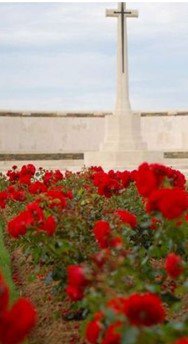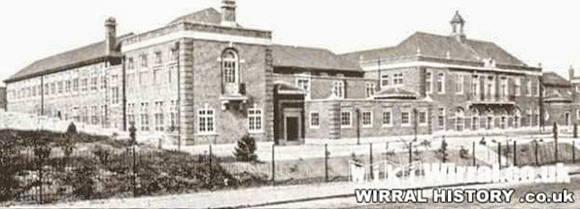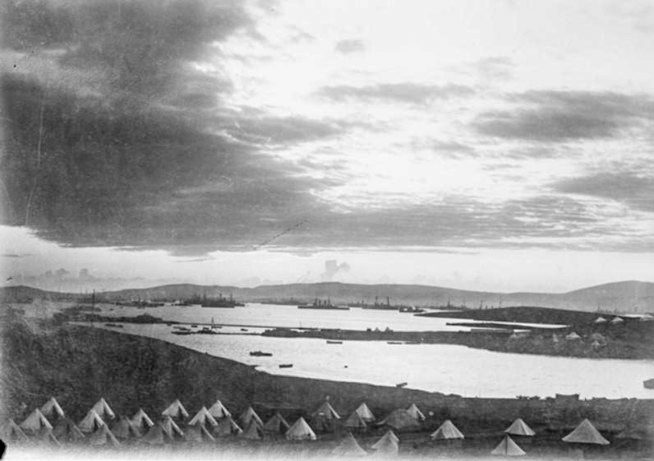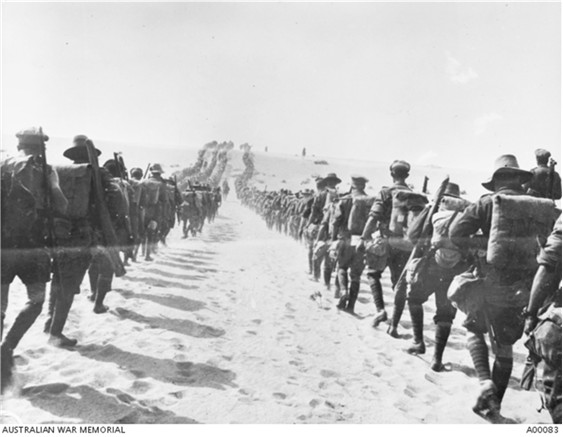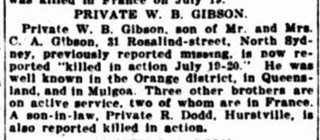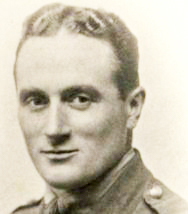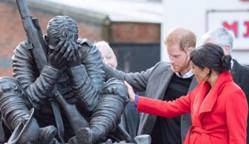Reginald DODD
Eyes hazel, Hair mid-brown, Complexion dark
Reg Dodd – From Cheshire to Hurstville, Fallen at Fromelles
Can you help find Reg?
Reg Dodd’s body was never found after the Battle of Fromelles, and there are no records of his burial. A mass grave was found in 2008 at Fromelles, a grave the Germans dug for 250 Australian soldiers they recovered after the battle. As of 2024, 180 of these soldiers have been able to be identified via DNA testing.
Reg may be among these remaining 70 unidentified men. There is still a chance to identify him — but we need help. We welcome all branches of his family to come forward to donate DNA to help with his identification, especially those with roots in especially those with roots in Tranmere, England.
See the DNA box at the end of the story for what we do know about his family. If you know anything of contacts for Walter, please contact the Fromelles Association.
Early Life - From Birkenhead to Hurstville, Sydney
Reginald (Reg) Dodd was born on 3 November 1880 in Tranmere, Birkenhead, Cheshire, England, the eldest son of James Dodd (1851–1925) and Emma Rebecca Haskell (1855–1941). His paternal grandfather, Joseph Dodd, was born in Ireland, while his grandmother, Margaret Laidman, came from Liverpool. On his mother’s side, he descended from the Haskell and Fearns families of Lancashire. The Dodd family lived at Tranmere, where James worked first as a clerk and bookkeeper and later as a brewer’s traveller.
Reg grew up alongside his younger siblings:
- James (1883–1958), who also enlisted in the AIF and served with the 9th Battalion at Gallipoli and later the 3rd Field Company Engineers, returning to Australia in 1919.
- Hilda (1887–1968), who married 2nd Lt. Leonard Dickinson of the York and Lancaster Regiment. Dickinson was killed in action in 1918, leaving Hilda widowed. She later remarried Stanley Graham Allison Slater.
Reg attended the Birkenhead Institute School, a private boy’s school. He spent three years with the Cheshire Volunteers
In the 1901 census, Reg was an apprentice carpenter, living with his family, including his 74 year old grandmother Ellen Haskell. His brother James was an apprentice fitter. Both Reg and James emigrated to Australia in 1909, but separately – Reg arrived on 30 September 1909 on the TSS Ayrshire and James on 8 September 1909. Reg settled in Sydney and James in Queensland. Reg settled in Hurstville, New South Wales and was working as a labourer.
In 1911 he married Margaret “Maggie” Pannett (1887-1972), an adopted daughter of Charles and Norah Gibson of North Sydney, who had come to Australia on the same ship as Reg.
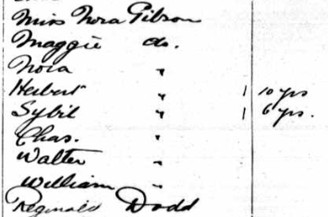
Unassisted Immigrant Passenger List, New South Wales, Australia
Reg and Maggie welcomed a daughter, Hilda Emma, on 17 April 1913. They were living at Greenacre Road, Hurstville, New South Wales.
Off to War
A month after the Gallipoli landing, Reg enlisted in the AIF at Liverpool, New South Wales and was assigned to the 1st Battalion, 6th Reinforcements. He was 34 years old. Reg had previously spent three years in Cheshire Volunteers, on Reserve. Less than a month after enlisting, he embarked from Sydney on HM
AT Karoola . Reg was not the only member of his family to answer the call. A few months earlier, his younger brother James (457) had enlisted in Brisbane. James served at Gallipoli with the 9th Battalion and and later the 3rd Field Company Engineers, returning to Australia in 1919. Many other members of the Reg’s family were fought in the war – Reg’s brother-in-law William Bernard Gibson (4947, 54th Battalion), who, like Reg, would fall at Fromelles in July 1916, and his sister Hilda’s husband Leonard served in for the UK had been killed in 1918. Other sons from the Gibson family also served.
Gallipoli
Reg arrived at Gallipoli on 6 August 1915, just as the assault at Lone Pine was beginning, one of the fiercest battles of the Gallipoli campaign. From nightfall on 6 August to the night of 9 August, fierce fighting took place underground, in a complex maze of Ottoman tunnels. The Turkish front-line trenches had been roofed with heavy timber and earth, forcing the Australians to break through by tearing off logs or entering via uncovered trenches.
Once inside, they fought through a maze of saps and communication trenches, battling at close quarters with bayonets, bombs, rifles, and even fists. During these several bloody days, Reg was among the hundreds of casualties sustained by the 1st Brigade, struck in the forearm by a gunshot. He was required to be evacuated for treatment.
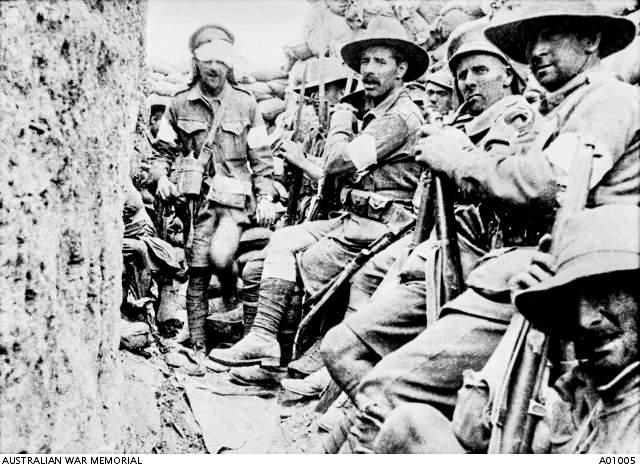
Reg was admitted to the 16th Stationary Hospital on Lemnos, then to a convalescent camp and finally to the 24th Casualty Clearing Station at Mudros. After weeks of treatment and recovery, he was discharged fit for duty on 14 September and rejoined his unit at Mudros West. He returned to Alexandria on 28 December 1915 as part of the evacuation of Gallipoli.
Egypt and Preparation for the Western Front
With the ‘doubling of the AIF’ as it expanded from two infantry divisions to five, major reorganisations were underway. The 53rd Battalion was formed on 16 February 1916 and was made up of Gallipoli veterans from the 1st Battalion and the new recruits from Australia. The Gallipoli soldiers in the 53rd were not slow in pointing out to whoever would listen that they were the “Dinkums” and the new recruits were the “War Babies”.
Source: - AWM4 23/70/1, 53rd Battalion War Diaries, Feb-July 1916, page 3
Training for all continued. In March they were sent to Ferry Post, on foot, a trip of about 60 km that took three days.
It was a significant challenge, walking over the soft sand in the 38°C heat with each man carrying their own possessions and 120 rounds of ammunition. Many of the men suffered heat stroke - Reg was admitted to the No. 1 New Zealand Field Ambulance at Moascar suffering from exhaustion, but he soon returned to duty. Once there, they remained at Ferry Post guarding the Suez Canal from any potential threats posed by the Ottoman Army . On 16 June when they began the move to the Western Front. 32 officers and 958 soldiers of the 53rd left Alexandria on 19 June on the troopship HMT Royal George, bound for Marseilles, France to become part of the British Expeditionary Force (BEF) on the Western Front.
They arrived in Marseilles on 28 June and immediately entrained for a 62-hour journey north to Hazebrouck before finally marching into the camp at nearby Thiennes in northern France. During their trip it was noted that their ‘reputation had evidently preceded them’, as they were well received by the French at the towns all along the route.
Source - AWM4 23/70/2 53rd Battalion War Diaries February - June 1916,
p. 4 This area near Fleurbaix was known as the “Nursery Sector” – a supposedly relatively quiet area where inexperienced Allied troops could learn the harsh realities of Western Front trench warfare against the Germans. But the quiet times and the training period did not last long. However, on 11 July Reg was briefly detached “On Command” to go to the Paris Exhibition, which included an Exposition of works of art damaged or rescued from regions devastated by the enemy. After this brief exposure to the elite art world of Paris, he rejoined his mates – on the day of the attack.
The Battle of Fromelles
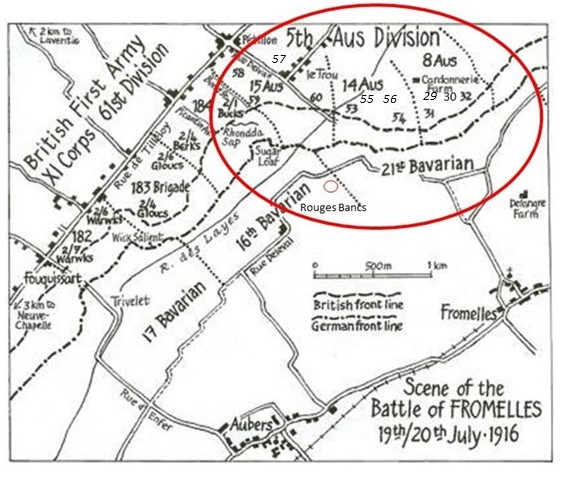
Just after arriving at his unit on the 19th, heavy bombardment was underway from both armies by 11.00 AM. At 4.00 PM all were now in position for battle. Zero Hour for advancing from their front-line trenches was to be 5.45 PM, but the Germans knew this attack was coming and were well-prepared. They opened a massive artillery bombardment on the Australians at 5.15 PM, causing chaos and many casualties.
The main objective for the 53rd was to take the trenches to the left of a heavily armed, elevated German defensive position, the ‘Sugar Loaf’, which dominated the front lines. If the Sugar Loaf could not be taken, the 53rd and the other battalions would be subjected to murderous enfiladed fire from the machine guns and counterattacks from that direction. As they advanced, they were to link up with the 60th and 54th Battalions on their flanks.
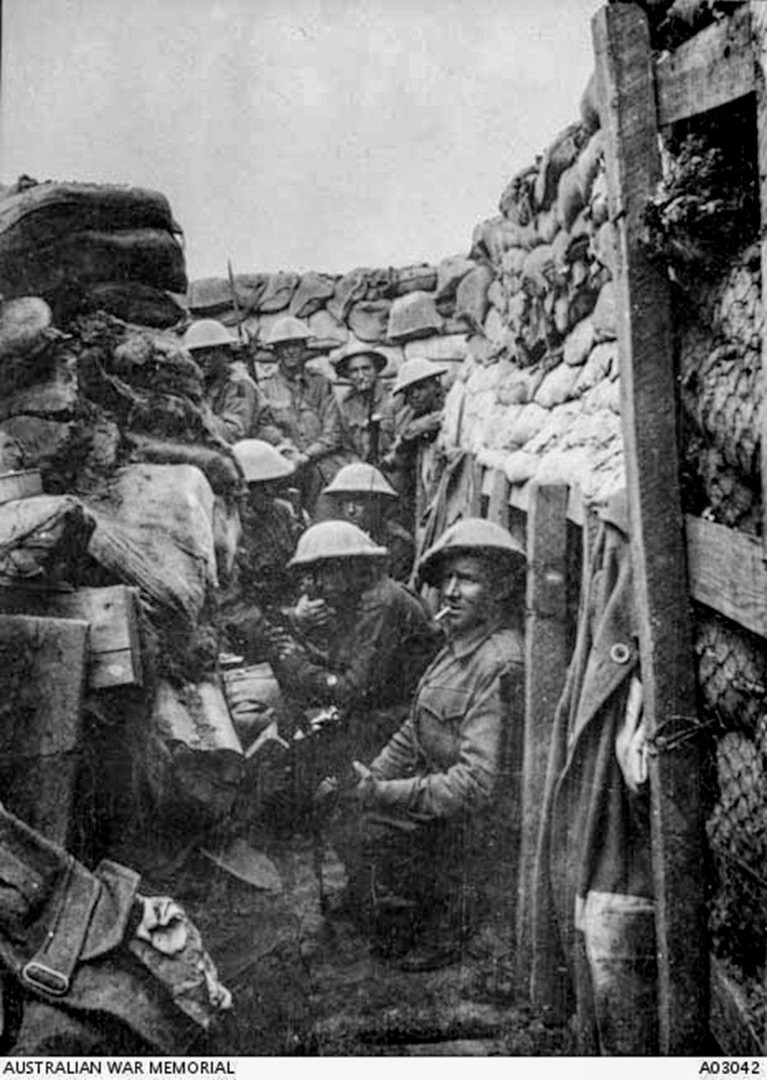
The Australians went on the offensive at 5.43 PM. They moved forward in four waves – half of A & B Companies in each of the first two waves and half of C & D in the third and fourth. They did not immediately charge the German lines, they went out into No-Man’s-Land and lay down, waiting for the British bombardment to lift. Private Arthur Crewes (4755) wrote of the time:
“At 5.43 pm the signal for the charge sounded, and over the top we went into the face of death, shells bursting, machine guns rattling and rifles crackling.”
At 6.00 PM the German lines were rushed. The 53rd were under heavy artillery, machine gun and rifle fire, but were able to advance rapidly.
Corporal J.T. James of C Company (3550) reported:
“At Fleurbaix on the 19th July we were attacking at 6 p.m. We took three lines of German trenches”
As below, the 14th Brigade War Diary notes that the artillery had been successful and “very few living Germans were found in the first and second line trenches”, but within the first 20 minutes the 53rd lost ALL the company commanders, ALL their seconds in command and six junior officers.
Source - AWM C E W Bean, The AIF in France, Vol 3, Chapter XII, pg 369
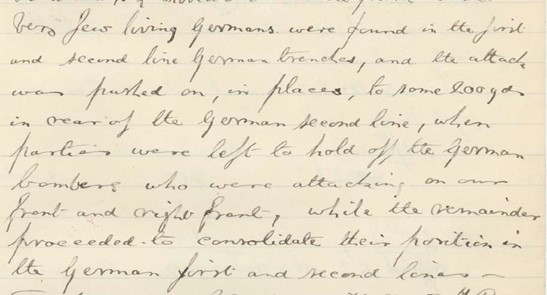
Some of the advanced trenches were just water filled ditches, which needed to be fortified by the 53rd to be able to hold their advanced position against future attacks.
They were able to link up with the 54th on their left and, with the 31st and 32nd, occupied a line from Rouges Bancs to near Delangre Farm, but the 60th on their right had been unable to advance due to the devastation from the machine gun emplacement at the Sugar Loaf.
They held their lines through the night against “violent” attacks from the Germans from the front, but their exposed right flank had allowed the Germans access to the first line trench BEHIND the 53rd, requiring the Australians to later have to fight their way back to their own lines. By 9.00 AM on the 20th, the 53rd received orders to retreat from positions won and by 9.30 AM they had “retired with very heavy loss”.
Source - AWM4 23/70/2 53rd Battalion War Diaries July 1916 page 7
Of the 990 men who had left Alexandria just weeks before, the initial count at roll call was 36 killed, 353 wounded and 236 missing.
`“Many heroic actions were performed.”`
Source: AWM4 23/70/2 53rd Battalion War Diaries July 1916 page 8
To get some perspective of the battle, when Charles Bean, Australia’s official war historian, attended the battlefield two and half years later, he observed a large quantity of bones, torn uniforms and Australian kit still on the battlefield. The final impact of the battle on the 53rd was 245 soldiers were killed or died from their wounds and, of this, 190 were not able to be identified.
After the Battle
Very little is known about what happened to Reg during the battle. Unlike many of his mates, there are no Army or Red Cross reports describing his involvement. For Reg’s family in Hurstville, the weeks after the Battle of Fromelles were filled with uncertainty. In early September, Maggie received the devastating news of Reg being killed through casualty notices in the Sydney Morning Herald, although it took until 29 November 1916 for Reg to be formally declared by the Army as having been killed in action.
His brother in law, William Gibson (4947, 54th) was also killed at Fromelles. The Gibsons placed a notice in the newspapers about William, their other serving sons and Reg.
After Reg’s death at Fromelles, Maggie continued to live with her family in North Sydney until 1922 when she married Herbert Hodges in Katoomba. They had a daughter, Iris Mary Hodges. Maggie lived a long life, passing away in 1972 at West Merrylands, New South Wales. Reg was awarded the 1914-15 Star Medal, the British War Medal, the Victory Medal, a Memorial Plaque and a Memorial Scroll.
He is commemorated at:
- V.C. Corner Australian Cemetery and Memorial, Fromelles, France
- Australian War Memorial, Roll of Honour, Panel 157, Canberra
- Birkenhead Institute Old Boys’ War Memorial and Roll of Honour, Cheshire, England
- Hurstville War Memorial, New South Wales, Australia
- On the family headstone in the cemetery in Bebington, Wirral, UK
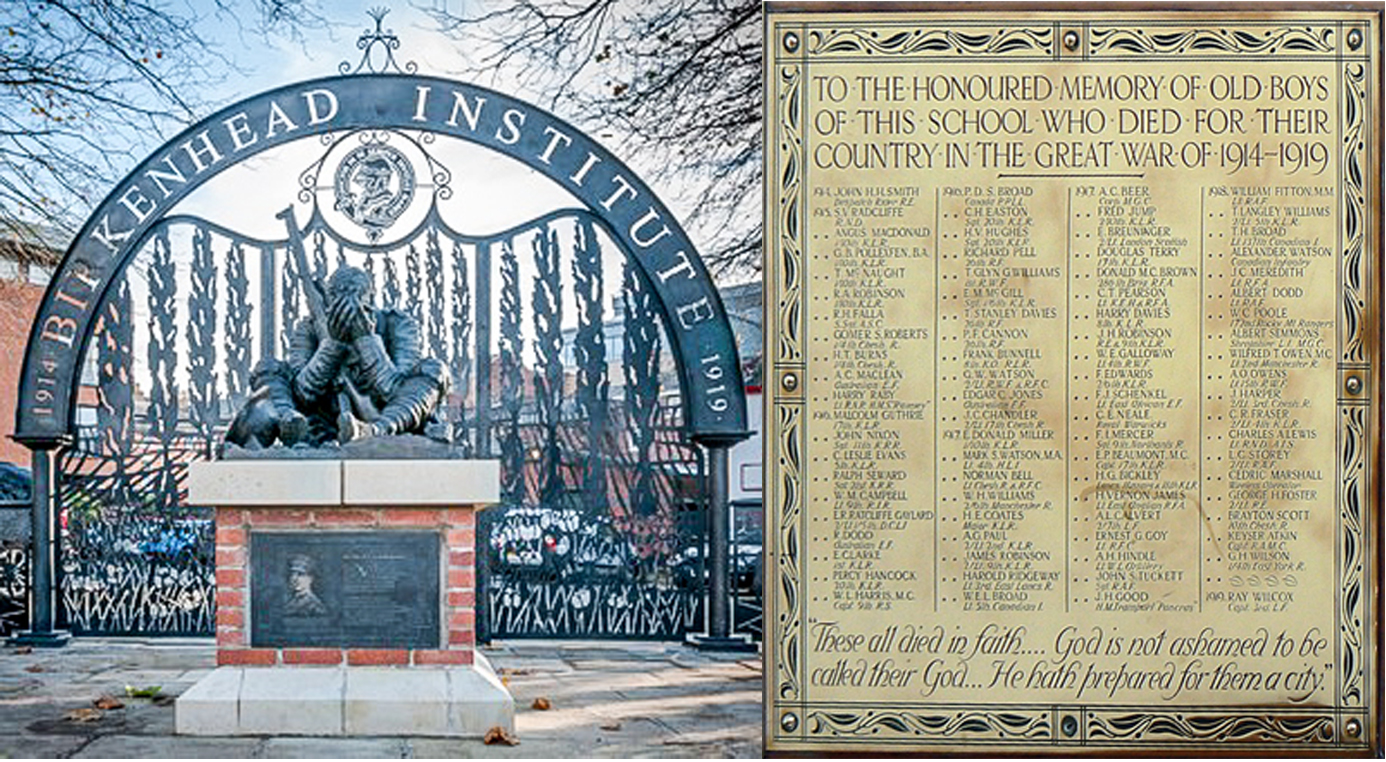
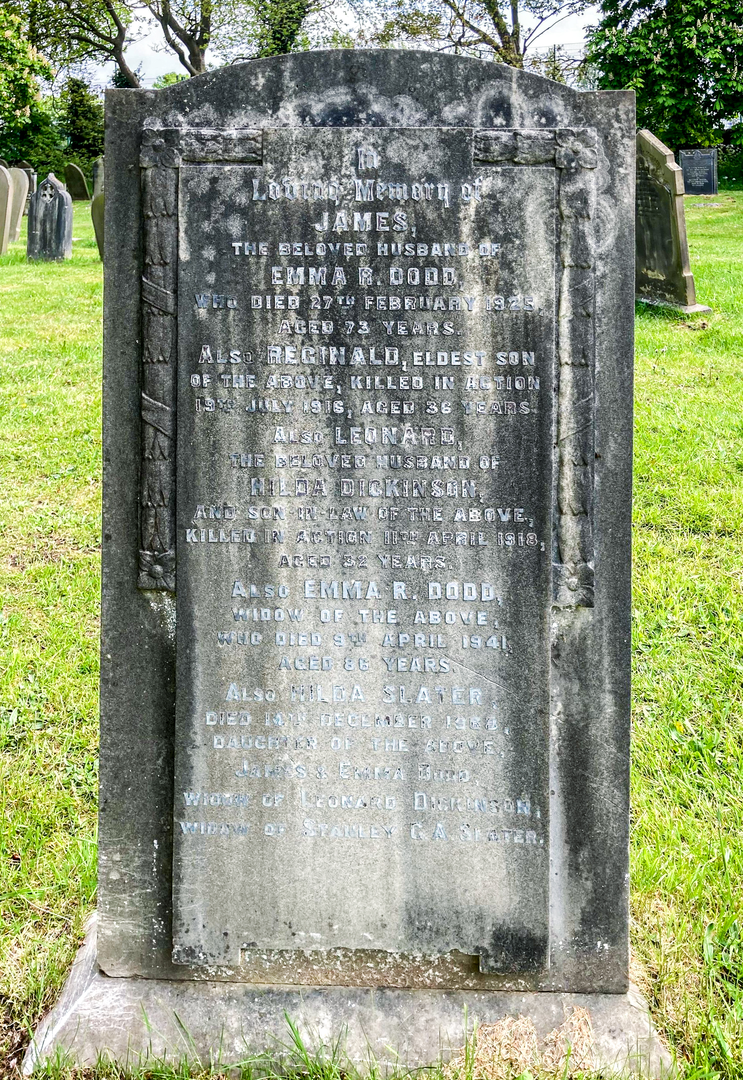
The Family at War
The war cast a long shadow across both the Dodd and Gibson families. Reg’s younger brother James had enlisted earlier, in January 1915. He served at Gallipoli with the 9th Battalion before transferring to the Engineers and serving in Europe. James returned to Australia in 1919. His wife Maggie’s family sent several sons to the front. Reg’s brother-in-law Private William Bernard Gibson (4947, 54th Battalion) was killed at Fromelles on the very same night as Reg. Another brother, Private Edward Gibson (2421, 13th Battalion), died of wounds in April 1917.
Other Gibson brothers served and returned, including Walter George Gibson with the 1st Motor Transport Company. Family tragedy also struck through Reg’s sister, Hilda Dodd. She had married 2nd Lieutenant Leonard Dickinson of the 12th Battalion, York and Lancaster Regiment. Leonard was killed in action on 11 April 1918. He also has no known grave; his name is commemorated on the Ploegsteert Memorial in Belgium. Hilda later remarried Stanley Graham Allison Slater of Prestatyn, Wales.
Legacy
Back home in Cheshire, his family were also mourning his loss. Reg is remembered on the headstone of his close family members. At his old school, Birkenhead Institute, Reg’s name was inscribed on the war memorial. Another Old Boy remembered there is the poet Wilfred Owen, who also fell on the Western Front. Owen’s words in Futility could well have been written for men like Reg:
Futility by Wilfred Owen
Move him into the sun—
Gently its touch awoke him once,
At home, whispering of fields half-sown.
Always it woke him, even in France,
Until this morning and this snow.
If anything might rouse him now
The kind old sun will know.
Think how it wakes the seeds—
Woke once the clays of a cold star.
Are limbs, so dear-achieved, are sides,
Full-nerved, still warm, too hard to stir?
Was it for this the clay grew tall?—
O what made fatuous sunbeams toil
To break earth’s sleep at all?
In 2019, a new ‘Futility’ statue was unveiled in Hamilton Square, within sight of the town’s cenotaph. Sculpted from an original drawing by Birkenhead Institute’s art master David Jones, it shows a weary but unbowed soldier — an “ordinary man called upon to perform extraordinary deeds.” On its plinth are inscribed the words of Owen’s poem Futility, a tribute both to the eighty-eight Old Boys of the Institute who fell in the Great War, and to the enduring cost of war borne by men like Reg.
Finding Reg
Reg’s remains were not recovered, he has no known grave. After the battle, the Germans recovered 250 Australian soldiers and placed them in a burial pit at Pheasant Wood. This grave was discovered in 2008 and since then efforts have been underway to identify these soldiers by DNA testing from family members. As of 2024, 180 of the soldiers have been identified, including 15 of the 190 unidentified soldiers from the 53rd Battalion. We welcome all branches of Reg’s family to come forward to donate DNA to help with his identification.
If you know anything of family contacts, particularly those with roots in Birkenhead, Cheshire, England, please contact the Fromelles Association. We hope that one day Reg will be named and honoured with a known grave.
Please visit Fromelles.info to follow the ongoing identification project and Reg’s story.
DNA samples are being sought for family connections to
| Soldier | Reginald Dodd (1880–1916) married Margaret “Maggie” Gibson nee Pannett |
| Child | Hilda Emma Dodd (1913-1984) married Alexander Edward Cumming in 1941, 4 children |
| Parents | James Dodd (1851–1925), Birkenhead, Cheshire, England; Emma Rebecca Haskell (1855–1941), Birkenhead, Cheshire, England |
| Siblings | James Dodd (1883–1958) | ||
| Hilda Dodd (1887–1968) – married Leonard Dickinson (KIA 1918) then Stanley Graham Allison Slater |
| Grandparents | |||
| Paternal | Joseph Dodd (1823–1874), Ireland and Margaret Laidman (1826–1887), Liverpool | ||
| Maternal | Thomas Tate Haskell (1823–1895), Liverpool and Ellen Taylor Fearns (1827–1906), Ormskirk, Lancashire |
Seeking DNA Donors

Contacts
(Contact: carla@fromelles.info or geoffrey@fromelles.info).
(Contact: army.uwc@defence.gov.au or phone 1800 019 090).
Donations
If you are able, please contribute to the upkeep of this resource.
(Contact: bill@fromelles.info ).
